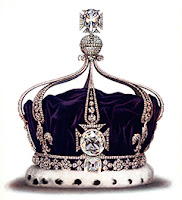By Tara Kingston
For centuries, precious jewels have been treasured for their beauty and scarcity. Gems such as crimson rubies, rich blue sapphires, and sparkling diamonds adorn the crowns of royalty and have been passed down through families as cherished heirlooms. But is it possible that some of the most legendary gemstones actually brought misfortune to their owners? Is it conceivable that a gleaming stone could actually bring tragedy upon the one who possesses it? Here’s a look at some gems that are rumored to carry a curse:
For centuries, precious jewels have been treasured for their beauty and scarcity. Gems such as crimson rubies, rich blue sapphires, and sparkling diamonds adorn the crowns of royalty and have been passed down through families as cherished heirlooms. But is it possible that some of the most legendary gemstones actually brought misfortune to their owners? Is it conceivable that a gleaming stone could actually bring tragedy upon the one who possesses it? Here’s a look at some gems that are rumored to carry a curse:
The Hope Diamond
 |
| Steel Engraving - Marie Antoinette before her Execution |
 |
| Evalyn Walsh McLean |
Decades later, American heiress Evalyn Walsh McLean acquired the diamond in 1910. She suffered great tragedy after the purchase, including the death of two of her children. After Mrs. McLean’s death in 1947, the diamond was purchased by Harry Winston, who later donated the jewel to the Smithsonian Institution.
The Koh-I-Noor Diamond
 |
| Koh-I-Noor Diamond |
 |
| Queen Mary's Crown |
The Black Prince’s Ruby
 |
| Imperial State Crown |
Many other rare gemstones including the Star of India, the Black Orlov diamond, and the Sancy diamond are associated with deadly curses. So, what are your thoughts—are these legends based in truth or mere superstition?
To learn more about these gems:
http://www.pbs.org/treasuresoftheworld/a_nav/hope_nav/hnav_level_1/1_past_hopfrm.html
http://www.si.edu/Encyclopedia_SI/nmnh/hope.htm
https://en.wikipedia.org/wiki/Koh-i-Noor
https://en.wikipedia.org/wiki/Black_Prince's_Ruby
All photographs and historical images are in the public domain.
About The Author:
 |
| To Purchase or Read An Excerpt |
Click the links to connect with Tara at www.tarakingston.com and on

